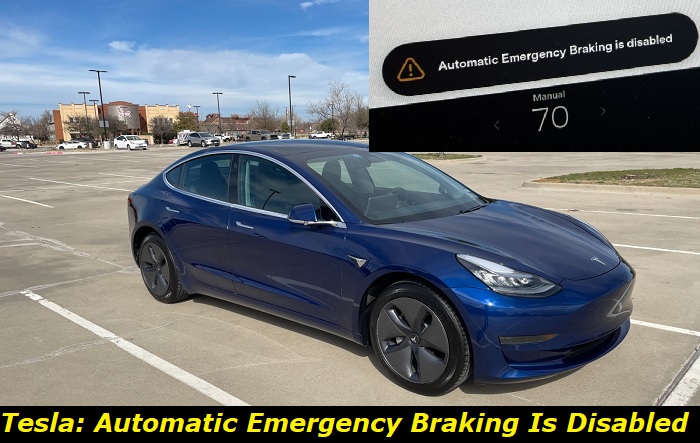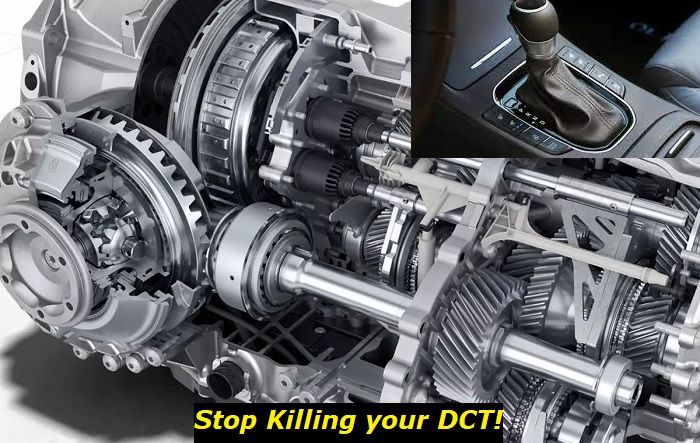Tesla Model 3 is a suave four-door sedan that gives its driver and passengers the ultimate good feel of a good battery-powered car. Since its launch in 2017, Model 3 has grabbed accolades in the USA and Europe. It is a car that has helped pave the way for future EVs. But like every car, whether fuel-powered or an EV, the Tesla Model 3 has its fair share of issues.
Automatic emergency braking is unavailable message highlights
- Common reasons:12V battery issues, water intrusion, software glitch
- How to fix:install updates, check the 12V battery voltage, have the car inspected
- Possible consequences:several smart functions will stop working
- Priority level:Medium
- Can you drive?Yes
- DIY repair:Possible
- Repair price range:$0-$450

Automatic emergency braking (AEB) in your Tesla Model 3
Tesla Model 3, like other Tesla models, is equipped with AEB, which is designed to determine the distance of objects from the car. The AEB kicks in when a collision is considered inevitable. The car applies the AEB in such situations to help reduce the vehicle's speed, consequently, the severity of the impact.
The functionality of the AEB is determined and affected by several factors, such as the car's speed and the environment. Once the AEB brakes are applied, the infotainment screen sounds a chime and displays a visual warning. According to Tesla, you should also notice the brake pedal actually making a downward movement. As the brake gets depressed, the brake lights turn on to let other road users know the car is slowing down.
The AEB will only work when the car is moving at 5km/h -200km/h. the AEB will stop working when you press and release the brake pedal. The assumption is that the danger or reason for applying AEB has been evaded. The AEB will also not work or stop working when you turn the steering wheel sharply, when an object has moved away, or when you accelerate hard.
Tesla warns Model 3 drivers that the availability of automatic emergency braking is not a substitute for maintaining a safe distance between your car and the car in front of you. You will still need to practice safe driving. The driver is warned that they should be aware of the road and the environment because, whereas AEB helps make Model 3 safer, it is not a substitute for the driver applying the brakes.
APP_W009 Automatic Emergency Braking is Unavailable
While driving your Tesla Model 3, you may have noticed a short message at the bottom of the infotainment screen telling you that the automatic emergency braking system is unavailable. Of course, this is a cause for concern.
According to Tesla, this warning message means the automatic emergency braking (AEB) will be unavailable for the rest of your current drive. The company, according to its troubleshooting page, says the problem can arise due to a number of reasons. Tesla further clarifies that this message does not necessarily mean that other braking features or functions are unavailable.
This warning message helps to make you aware that the AEB is experiencing some problems. It is also possible to see other alerts notifying you of conditions that can cause the 'Automatic Emergency Braking is unavailable' message to appear on the dash. Therefore, you should pay attention to the dash while driving because an alert relating to the CAS might cause the AEB unavailable message down the road.
How to fix the problem
Tesla advises the driver to do nothing when the 'AEB is unavailable' message appears. Normally, the vehicle will self-diagnose once you switch off the car. The next time you switch on the engine or go for the next drive, the message will not appear. If the message keeps appearing or remains stubbornly on the dashboard, it is time to consider taking action. Tesla advises you to take your car to the nearest Tesla service center.
- According to many Model 3 owners who encountered this problem, letting the car sleep overnight clears the message. For others, the problem went away after letting the car sleep for a few hours. Sometimes you may need to consider checking the various systems and components connected to the AEB.
- The camera is one of the components and systems integrated with the AEB. Some debris might be blocking the camera, making the automatic emergency braking inoperable. This will cause the AEB to be disabled, making the car undrivable and failing to prevent an accident since the camera view is distorted or disrupted.
- Recalibration of the cameras will help resolve this problem. The cameras are designed or positioned in a specific way to allow their effective application by the various systems and car apps. A shifting of the angle of the AEB camera can make the whole automatic braking system go haywire.
- For some Model 3 owners, recalibration of the cameras has been shown to solve the APP_W009 issue. The process requires going to controls > Service > Camera calibration > Clear calibration. You should then drive for at least 25 miles to allow for the calibration to take place. You will be able to monitor the calibration progress on the touchscreen.
- When you take your Model 3 to the service center, they will conduct many tests to establish what is causing the problem and understand why the car is not rebooting. One of the solutions to the problem usually involves software updates. An outdated software could cause the AEB system to malfunction, making the 'AEB unavailable' message pop on the dash.
- Some Model 3 owners have had the car's computer replaced. In some cases, the entire car computer could be at fault, and replacing it is the only option. This has been witnessed by several Model 3 owners who have seen the CPUs in their cars replaced.
What causes APP_W009?
- Debris on the camera can cause the AEB to malfunction. The AEB uses the inbuilt camera to detect objects so that it can be applied. Model 3 has eight cameras, and the AEB utilizes the main camera at the front of the car and the dashcam inside the cabin.
- When the cameras are damaged, the AEB may fail and send an 'AEB is unavailable' message. This can be due to a collision, even if a fender-bender touches the main camera.
- A damaged onboard car computer will fail to interpret signals or fail to send the correct ones. This means the information received from the cameras can be interpreted wrong. It can also mean erroneous information can be sent to the AEB, making the system fail or apply the brakes at the wrong places.
- The 'automatic emergency braking is unavailable message will also appear on the dash if some other but related braking problem arises. This can be a problem touching the wiring, braking fluid, or sensors. For this reason, you should seek Tesla service center help when this message persists.
- It is possible to turn off the automatic emergency braking in your Model 3. Disabling this feature means the car will no longer reduce the speed when there is a pedestrian crossing and you are not seeing them. You may have inadvertently disabled the AEB, in which case you will need to go to controls > autopilot > Automatic emergency braking to activate it.
Conclusion
The 'automatic emergency braking is unavailable' in Model 3 is a message that many Tesla lovers have encountered. However, after reading this article, you can rest easy knowing that the message does not mean the braking system has an issue. The above steps should help you resolve the problems fast and without much inconvenience.
About the authors
The CarAraC research team is composed of seasoned auto mechanics and automotive industry professionals, including individuals with advanced degrees and certifications in their field. Our team members boast prestigious credentials, reflecting their extensive knowledge and skills. These qualifications include: IMI: Institute of the Motor Industry, ASE-Certified Master Automobile Technicians; Coventry University, Graduate of MA in Automotive Journalism; Politecnico di Torino, Italy, MS Automotive Engineering; Ss. Cyril and Methodius University in Skopje, Mechanical University in Skopje; TOC Automotive College; DHA Suffa University, Department of Mechanical Engineering






Add comment